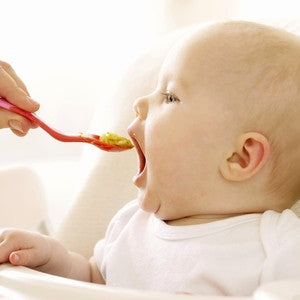

Baby food stages: Introducing solids to your baby
When will my baby be ready for solids?
After several months of exclusively feeding your baby milk or formula you might be asking when you can finally start feeding him or her solid foods. The AAP officially recommends starting solids with your baby somewhere between 4 and 6 months, but there are several signs that indicate when your baby is ready. One of the biggest signs is increased oral coordination with a calming of the tongue thrust reflex. This reflex causes the baby to push their tongue out when eating and prevents a baby from swallowing solid foods. Once your baby starts to develop the ability to swallow, it’s probably time to start slowly introducing solid stage 1 - first foods for baby. It is important to remember though that you are not trying to replace breast milk or formula with solids, instead you are adding solids on top of their current diet. Over the next few months you will slowly start to introduce foods with thicker consistencies and work your baby towards eating an all solid diet.
What are the 3 stages of baby food?
The 3 stages of babies first foods were created to help parents slowly transition their babies from liquids to solid foods. At each stage you will introduce thicker foods to your baby in order to build up their digestive system and ease them into solids. Below is an outline for the types of foods your baby will eat at each stage and some general signs for when your baby is ready to move on. For more information on how much breast milk or formula to be giving your baby during these times please check out our other article here .
Stage 1:
- Typically introduced around 4-6 months
- All foods are single ingredients and purees
- Slowly introduce new foods every few days and be careful to pay attention to your baby’s reaction to different foods.
- Avoid common or family allergens until after the 1st year.
- For more information on stage 1 baby food, check out our more in-depth article here.
Stage 2:
- Typically introduced around 6-8 months
- Slightly thicker foods with mixed ingredients
- Larger portions as baby continues to grow
Stage 3:
- Typically introduced around 8-10 months
- Mashed instead of pureed to add more texture
- May have bits or chunks of meats, fruits, or veggies in them
Some Important Things to Remember When Starting Solids
- Only ever offer your baby food that is age appropriate. Use the guidelines above and advice from your pediatrician before trying new foods.
- Offer your baby breast milk and/or formula before trying solids. Your baby will be more interested in solids when he/she is a little hungry but not starving.
- Always ensure that your baby is sitting upright. If he/she cannot sit upright unassisted and does not have proper head control, it may not be the right time to begin solid foods.
- Introduce new foods during the morning or early afternoon. This will allow you to deal with any adverse reactions when your pediatrician is in the office and it will cause the least amount of disruption in your baby’s fragile routine.
- Use a soft comfy utensil when feeding your baby. Baby’s gums are very sensitive from teething and a hard metal spoon may aggravate baby’s gums.
- Never force your baby to eat. Always let your baby eat at her own pace and on her own terms. When your baby turns away or stops opening his/her mouth, that probably means she has had enough and you should respect that.
- Don’t give up on a new food because baby won’t eat it the first time; continue offering the food or wait another day or week.
- Don’t worry about the mess, at least while your baby is eating. Cleaning up can distract your baby and throw off meals. There will undoubtedly be a mess when feeding your baby, let it happen and don’t worry about it until after your baby is full.
